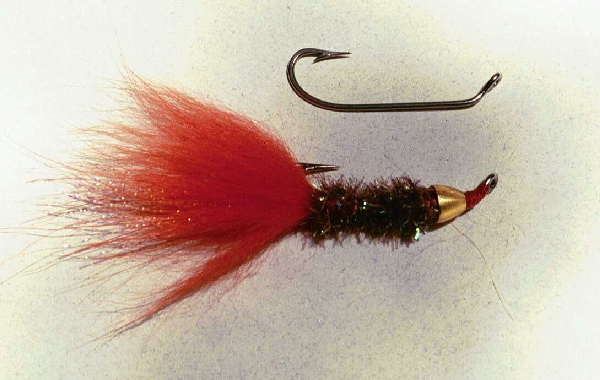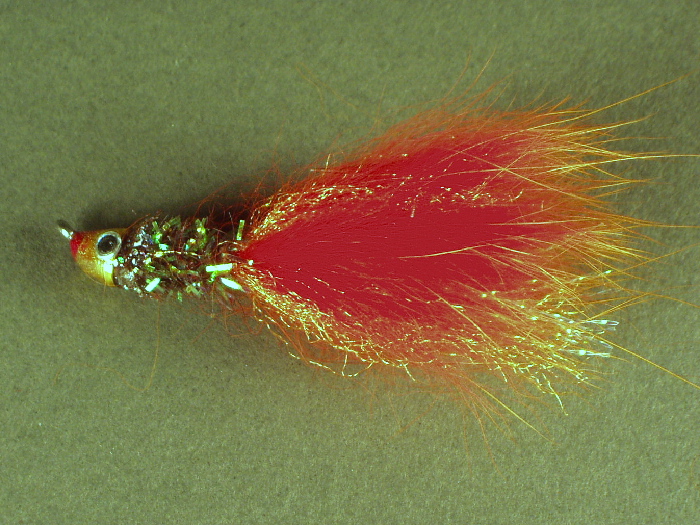Date: June 2002

Early Version

Current Version
Derivation and Use: The form is patterned after the grub that has been so effective for surfperch. It is a very simple and fast tie. The body color is similar to the motor oil color of grubs used for surfperch. The hot orange tail triggers the bite response on sand crab roe (orange) and improves visibility in turbulent/sandy/foamy surf. Jig hooks have become the favorite in our Northern California Striper community because it allows the fly to ride barb up and resist weed fouling. The jig hook also has superior sticking ability because the hook eye is in-line with the point. For surf fishing, sand crab and debris snagging is minimized because the hook rides up in the flow shadow of the cone head and 60-degree bend. Under low current conditions, I have found the early version more effective then other surf flies that I have used for surfperch. I typically use it on point with a complementary fly on my dropper (usually a fly with eyes). Use foot-long moderate to rapid but smooth strips making sure that you maintain contact with the Miki. Strip set upon any signal that the dynamics of the line/fly have changed. Sweep set again to assure that the hook is not precariously lodged against the crushers inside the perch's mouth. I use lead core (LC-13) and mono running line. I typically do not count down after casting. The Miki tail may wear down in the course of a day's fishing so will have to be replaced. The current version is in development for higher current conditions.
Hook: Mustad 34011, Stainless Steel, Sizes 4 or 6 converted to 60-degree jig hook by bending with pliers or vise. Size 6 has superior hit rate. Use size 4 to be selective to large fish when a school of spawners are in front of you. For fishing larger surf (higher current flows), I have found that a shorter hook with an upturned eye is more effective, so my standard hook now is a Tiemco 5262 (a bronzed fresh water hook). It holds up fine if you rinse with fresh water and dry after a day's fishing.
Head: Small Gold Cone - You may have to drill (1/16 inch) to clear barb and get around bend. Build up hook under head to eliminate clearance and lock the tip in place with red thread (BCTC Nymo or Uni-thread 3/0) and whip finish. Lock in the back of the cone with repeated turns. You can add small stick on prismatic eyes the epoxy coat to protect.
Tail: Pearl Crystal Flash in center with Hot Orange Artic Fox Fur - use approx 10 strands of crystal flash (a little longer then the body length) clumped in the center of the tail secure with thread and add artic fox hair (as long as the body length). Crystal should extend beyond the fur by 1/8 to 1/4 inch. Hair from Magnum Rabbit Strips can be substituted (Hareline Dubbin) or the finest Hot Orange Bucktail or calf tail. Try to find Artic Fox Fur with a lot of guard hair for better wearing qualities. The tail can be retrofitted after wearing - just tie in more artic fox fur and cement thread, whip finish and cement thread leaving a narrow red band at base of tail. You can add 2 to 4 strips of combed out orange antron above and below the tail to protect it from sand and hook up abrasion.
Body: Doug's Bugs Crystal Chenille in Brown (the colors are really strong in metallic green flash with brown). I use medium length with fibers approx. 1/8 inch long. Tie in chenille after tail is secured. It is important to use build a base of thread over the shank of the hook with a moderate coating of head cement (Fleximent) to lock in the chenille fibers. Work forward and then tie off chenille behind the cone head leaving a narrow red band of thread. Coat with head cement - let dry then give the entire red collar, cone head areas a liberal coating of Softex to protect these areas from sand abrasion. If eyes are used then coat the entire cone and eyes with epoxy.
Questions or Comments Contact: Glenn Yoshimoto
glenn@zenflyfishing.com
Los Gatos, California
 zen fly fishing home
zen fly fishing home
This page © Copyright 2002, Glenn Yoshimoto